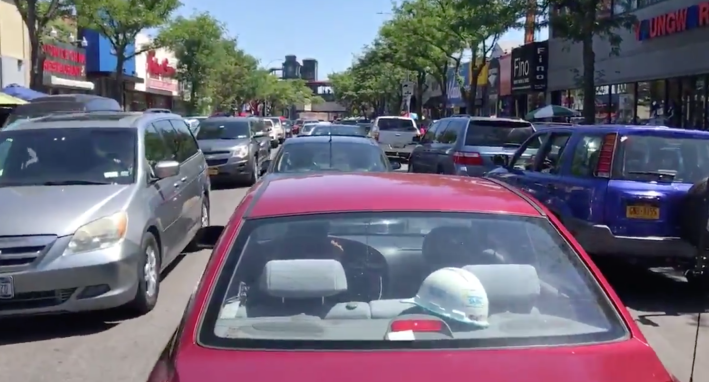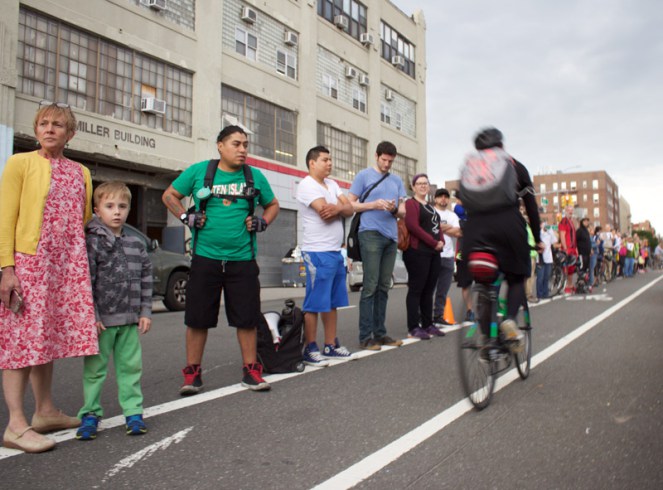I have a tendency to write angry when opponents of street safety simply ignore facts that don't serve their Trumpian approach to protected bike lanes and other improvements.
But the editor of the Queens Chronicle, Peter Mastrosimone, graciously offered me a chance to write a letter to the editor after he published a biased, anti-bike article this week about the ongoing protests in Sunnyside. So I decided to try reason rather than my usual bitterness. Tell me how I did.
To the editor,
Your Oct. 18 article, "Video shows FDNY blocked from Skillman," was the latest in a series of biased coverage that has become common since the installation of vital safety improvements along Skillman and 43rd avenues in Sunnyside.
I appreciate your invitation to offer your readers a different view. I don't believe I will change any minds, but I do hope bike-lane opponents will at least hear me out, as I have spent so many years listening to them at community board meetings in my 25 years as a New York City reporter, motorist and, yes, cyclist.
The article — and the bike lane opponents it quotes — seeks to blame the protected bike lane for congestion along the avenues, specifically citing a video of a fire truck unable to turn onto Skillman Avenue. But like other such videos that are proliferating on social media, this one also reveals clearly that the bike lane is not the problem. The problem is the illegally parked cars. Michael Gannon's article acknowledges this fact in the lede, but then reverts to standard-issue bike bashing.
The story's centerpiece was a statement by Gerard Fitzgerald, president of the Uniformed Firefighters Association, who ignored the illegally parked cars in his attack on street safety designs.
"Extended bike lanes affect traffic patterns and block access to necessary equipment for our men and women in uniform to perform their jobs effectively," he claimed, citing not a single example.
The article should have pointed out that the FDNY was consulted by the Department of Transportation at every step of the debate over the Skillman and 43rd bike lanes. The article should have pointed out that the FDNY supported the installation. I reached out to the FDNY press office after reading Gannon's article and was reminded by an agency spokesman that Fitzgerald speaks for himself, not the FDNY.
Beyond Fitzpatrick's statement, it's worth pointing out that very few FDNY workers live in the communities they serve. Rather, our firefighting heroes typically commute to work via car. Individual firefighters' opinions are valid, of course, but should be read in the context of people who see a neighborhood as just something to drive to in the morning and drive out of every night rather than residents who care about what's best for a neighborhood. They are mere commuters who leave when their shift is done. We wouldn't listen to commuters from New Jersey telling us how New York City streets should be designed, would we?
On that topic, I would also like to remind your readers who drive that the roadways were not created solely for them or for them to store their vehicles when not in use. Indeed, on-street car storage — you call it "parking" — was not common in New York until 1954, when rules were changed to give idle vehicles hegemony over our curbside space.

But don't forget: The roadway is a public right of way, meaning we, as the public, can decide how to use it. In a dense urban area, we should use it to promote the most-efficient, most environmentally sound methods of moving people around a city: public transit. Gannon bemoaned the traffic that he witnessed on Skillman Avenue, but if he viewed the street with objective eyes, he would have seen dozens of single-occupancy vehicles — plus dozens more, motionless vehicles with no one in them at all — taking up the same amount of space in the public right of way that could have been occupied by buses transporting thousands of people. The dozens of bicycles you see on the new bike lanes — and the hundreds more that will soon join them thanks to the safety improvements — also move people far more efficiently and occupy far less space than cars.
Like many articles of this ilk, Gannon's relies on anecdotes rather than evidence. One convenience store owner claimed, for example, that his business has been adversely affected by the bike lane.
“With less parking, people don’t stop as much,” said Sheikh Akram, who run the shop at the northeast corner of Skillman and 51st Street.
I've lived in New York City for 30 years — in four boroughs, no less! — and I cannot tell you a single time I have driven to a convenience store. There is simply no way that Akram is correct that parking has been the foundation of his business. If his sales are suffering — and that's a big "if" — there are multiple factors at work: changing customer demographics, competition from online retailers such as Amazon or Fresh Direct, his prices, his offerings, his staff, the weather on the day Gannon chose to interview him, etc.
Akram's comment reminded me of the owner of Ben's Best on Queens Boulevard, who complained that the demise of his business stemmed from the life-saving bike lane rather than the fact that there were fewer and fewer customers for expensive, high-fat pastrami sandwiches in diversifying Rego Park. Neighborhoods change over time — and savvy business owners know how to change with the times, offering new residents what they want. The customer is always right. Business that don't adapt go, well, out of business.
Another anecdote was provided by a resident who said "she had nearly been struck by a cyclist speeding through a red light."
I'm a cyclist who is "nearly struck" every single minute of my daily commute by drivers, and can refer your readers to thousands of videos posted online of the near misses we cyclists face every day. But if we are going to debate public safety, let's stick to hard evidence, not the soft bias of commuters who don't like other commuters who happen to choose a different mode.
So here are the facts: Protected bike lanes make the roadway safer for all users. Data from the Department of Transportation show that crashes resulting in injuries go down by nearly 20 percent; injuries to pedestrians drop by more than 20 percent; and the total number of cyclist injuries drops, even as cycling volumes increase; travel times for drivers on roadways remains the same or actually improves; pedestrians get shorter crossing distances, which makes neighborhoods more walkable and inviting; speeding declines dramatically; and business activity increases. It does not decrease.
I can't believe that, after more than a decade of these improvements, these facts even need to be restated. I know that change is hard. But change is the only way to fix things that aren't working.

Above all, the article should have reminded the readers of the crucial timeline for the protected bike lanes in Sunnyside: They were initially championed by Council Member Jimmy Van Bramer and Community Board 2 Chairwoman Denise Keehan-Smith after a cyclist, Gelacio Reyes, was killed by a motorist at 43rd Avenue and 39th Street, and cyclist David Nunez was critically injured by a truck driver at the same location 10 days later.
And those crashes were not isolated incidents. Between 2009 and the installation of the protected bike lanes this year, 145 pedestrians and 98 cyclists were injured by drivers on Skillman and 43rd avenues, according to city statistics.
Gannon's story does rightly point out that the lanes were controversial. But the article foolishly equated the warring camps: "cyclists, environmentalists and traffic safety advocates in favor; and residents divided among both camps." To me, that speaks for itself: Plenty of "residents" side with (and, indeed, are!) the "cyclists, environmentalists and traffic safety advocates." That means that the residents who do not are a tiny minority in a neighborhood that benefits every day from better street safety.
If would be great if that dead-end minority would listen to the facts. Instead, drivers have met the enemy — and it is everyone else but them.
Gersh Kuntzman is Editor-in-Chief of Streetsblog. When he gets angry, he writes the Cycle of Rage column. They’re archived here.






